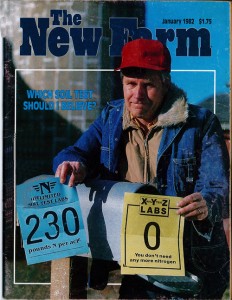
30 years ago … a soil test survey by Dr. Liebhardt rocked soil labs nationwide .. and still is exerting an influence … for the good.
It has been exactly 30 years this spring since Dr. William Liebhardt and colleagues published a carefully crafted survey of 69 USA soil test labs. In the ensuing uproar, some suggested Bill Liebhardt had thrown his career away. Recollecting the events, Bill (retired Ag Scientist, UC Davis CA) told us: “At agronomy meetings where we presented the results, there was standing room only left and out into the halls.” Woods End Labs was one of the 69 commercial labs that received blindly 5 farmer soils, with listed crop histories, and a request for recommendations to grow 125-bu corn. Woods End determined several of the soils were very fertile and required little added fertilizer, but the majority of surveyed labs did not agree.
The problem Liebhardt uncovered was not so much the soil testing per se, although there were disturbing differences such as in measuring soil organic content. The stinging issue was the way labs used (or did not use) test results to construct fertilizer recommendations. And the big one was, then as now, nitrogen. Only 15 labs adjusted N-prescriptions to apparent soil potential and only 3 labs, ours included, pin-pointed the high N-potential soils (rich humus and prior alfalfa in the rotation).
There have been many advances and improvements in soil testing since this time, yet nitrogen remains a challenge. The storehouse of potentially available N is the soil organic matter fraction which has been traditonally overlooked. Our 1982 soil reports showed some of Liebhardt’s PA soils were richly supplied at 4 – 5%OM. Natural biological release could be counted on to provide a significant contribution. Considering this, for most of the labs, the fertilizer N rates appeared excessive. This burning theme casts a long shadow: a very recent CA study suggests that excess nitrogen fertilizer is straining the state’s ability to deliver quality water.
The fact the majority of soil labs in 1982 did not account for soil’s intrinsic nitrogen potential is not surprising as methods to measure biological response were uncommon, leaving labs to either make potentially inaccurate calculations – or do nothing. Today, a combination of tools is available (plus soil proficiency programs to monitor testing) all of which may reduce the potential for excessive (and costly) fertilizer, yet the problem of labs not using any tests or tools other than crop requirements persists. Woods End’s Solvita CO2-Burst protocol is one newer means that did not exist earlier and which directly measures microbiological carbon turnover, the kingpin in potential N-release. Accounting for soluble N and adapting local soil and climatic factors will help make the new “soil health” approach a big step forward. (Copies of the original study and Woods End reports are available by request: lab@woodsend.com). Download references documents HERE

